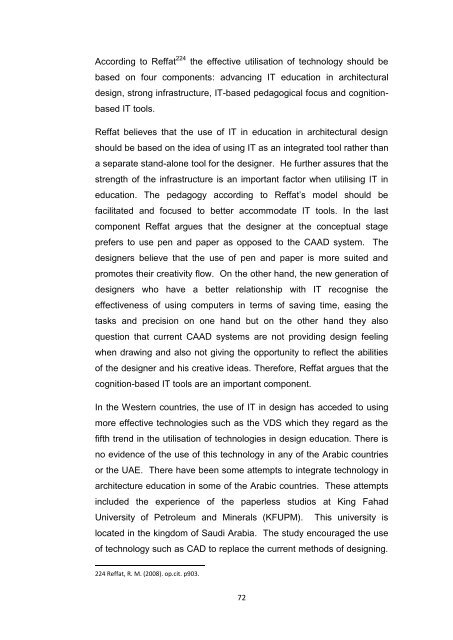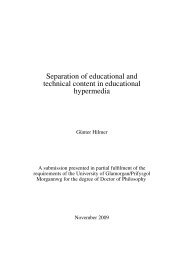framework for the implementation of a virtual design studio model in ...
framework for the implementation of a virtual design studio model in ...
framework for the implementation of a virtual design studio model in ...
Create successful ePaper yourself
Turn your PDF publications into a flip-book with our unique Google optimized e-Paper software.
Accord<strong>in</strong>g to Reffat 224 <strong>the</strong> effective utilisation <strong>of</strong> technology should be<br />
based on four components: advanc<strong>in</strong>g IT education <strong>in</strong> architectural<br />
<strong>design</strong>, strong <strong>in</strong>frastructure, IT-based pedagogical focus and cognition-<br />
based IT tools.<br />
Reffat believes that <strong>the</strong> use <strong>of</strong> IT <strong>in</strong> education <strong>in</strong> architectural <strong>design</strong><br />
should be based on <strong>the</strong> idea <strong>of</strong> us<strong>in</strong>g IT as an <strong>in</strong>tegrated tool ra<strong>the</strong>r than<br />
a separate stand-alone tool <strong>for</strong> <strong>the</strong> <strong>design</strong>er. He fur<strong>the</strong>r assures that <strong>the</strong><br />
strength <strong>of</strong> <strong>the</strong> <strong>in</strong>frastructure is an important factor when utilis<strong>in</strong>g IT <strong>in</strong><br />
education. The pedagogy accord<strong>in</strong>g to Reffat‟s <strong>model</strong> should be<br />
facilitated and focused to better accommodate IT tools. In <strong>the</strong> last<br />
component Reffat argues that <strong>the</strong> <strong>design</strong>er at <strong>the</strong> conceptual stage<br />
prefers to use pen and paper as opposed to <strong>the</strong> CAAD system. The<br />
<strong>design</strong>ers believe that <strong>the</strong> use <strong>of</strong> pen and paper is more suited and<br />
promotes <strong>the</strong>ir creativity flow. On <strong>the</strong> o<strong>the</strong>r hand, <strong>the</strong> new generation <strong>of</strong><br />
<strong>design</strong>ers who have a better relationship with IT recognise <strong>the</strong><br />
effectiveness <strong>of</strong> us<strong>in</strong>g computers <strong>in</strong> terms <strong>of</strong> sav<strong>in</strong>g time, eas<strong>in</strong>g <strong>the</strong><br />
tasks and precision on one hand but on <strong>the</strong> o<strong>the</strong>r hand <strong>the</strong>y also<br />
question that current CAAD systems are not provid<strong>in</strong>g <strong>design</strong> feel<strong>in</strong>g<br />
when draw<strong>in</strong>g and also not giv<strong>in</strong>g <strong>the</strong> opportunity to reflect <strong>the</strong> abilities<br />
<strong>of</strong> <strong>the</strong> <strong>design</strong>er and his creative ideas. There<strong>for</strong>e, Reffat argues that <strong>the</strong><br />
cognition-based IT tools are an important component.<br />
In <strong>the</strong> Western countries, <strong>the</strong> use <strong>of</strong> IT <strong>in</strong> <strong>design</strong> has acceded to us<strong>in</strong>g<br />
more effective technologies such as <strong>the</strong> VDS which <strong>the</strong>y regard as <strong>the</strong><br />
fifth trend <strong>in</strong> <strong>the</strong> utilisation <strong>of</strong> technologies <strong>in</strong> <strong>design</strong> education. There is<br />
no evidence <strong>of</strong> <strong>the</strong> use <strong>of</strong> this technology <strong>in</strong> any <strong>of</strong> <strong>the</strong> Arabic countries<br />
or <strong>the</strong> UAE. There have been some attempts to <strong>in</strong>tegrate technology <strong>in</strong><br />
architecture education <strong>in</strong> some <strong>of</strong> <strong>the</strong> Arabic countries. These attempts<br />
<strong>in</strong>cluded <strong>the</strong> experience <strong>of</strong> <strong>the</strong> paperless <strong>studio</strong>s at K<strong>in</strong>g Fahad<br />
University <strong>of</strong> Petroleum and M<strong>in</strong>erals (KFUPM). This university is<br />
located <strong>in</strong> <strong>the</strong> k<strong>in</strong>gdom <strong>of</strong> Saudi Arabia. The study encouraged <strong>the</strong> use<br />
<strong>of</strong> technology such as CAD to replace <strong>the</strong> current methods <strong>of</strong> <strong>design</strong><strong>in</strong>g.<br />
224 Reffat, R. M. (2008). op.cit. p903.<br />
72



